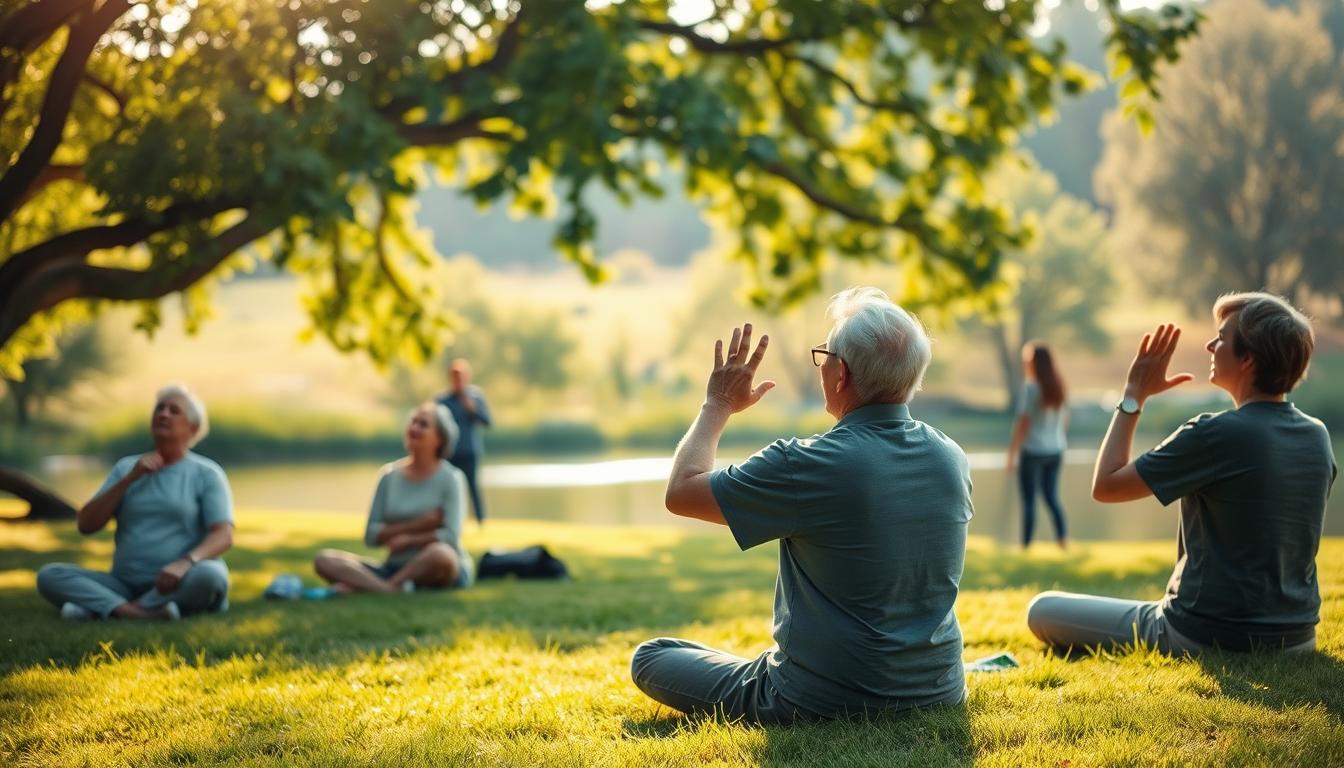Imagine trying to read a menu or text message and squinting to see the words. This is a common problem for many over 40. The search for reading glasses or the tired eyes from screens can be tiring.
But, is there a way to make these challenges easier without surgery or thick glasses? Millions of people over 40 are finding a simpler way. They’re using a natural routine to improve their vision, reduce eye strain, and feel more confident.
This routine includes eating foods rich in nutrients, doing eye exercises, and making smart lifestyle changes. It’s not just a dream—it’s what many people do every day.
Key Takeaways
- Age-related vision changes are normal but manageable through daily habits.
- Nutrition and exercise play a bigger role in eyesight than many realize.
- Thousands are choosing natural methods to avoid over-reliance on corrective lenses.
- Small adjustments can lead to noticeable improvements in focus and clarity.
- Protecting vision starts with understanding your eyes’ natural needs.
Why Vision Changes After 40 and What You Can Do About It
As you get closer to 40, your eyes start to change in small ways. These changes are part of aging. Knowing about these changes is the first step to vision improvement over 40.

The Natural Aging Process of Your Eyes
The lens in your eye gets less flexible with age. This makes it harder to focus on close things, known as presbyopia. The muscles around the lens also get weaker, making it harder to switch between near and far tasks.
Common Vision Complaints Among Those Over 40
- Blurred text when reading books or menus
- Eye strain after screen use
- Difficulty seeing in low light
- Headaches from prolonged close work
Why Traditional Solutions Fall Short
Reading glasses or bifocals might seem like easy fixes, but they don’t solve the real problem. Relying too much on them can make your eyes less flexible over time. A 2023 study by the American Optometric Association found that 68% of people still get eye fatigue even with corrective lenses.
| Traditional Solutions | Natural Approaches |
|---|---|
| Reading glasses | Eye exercises |
| Progressive lenses | Nutrient-rich diets |
| Temporary fixes | Long-term eye health |
Making small changes every day can help your eyes stay healthy. Combining these changes with regular eye exams is a good way to improve your vision as you get older.
See the Natural Routine People Over 40 Are Using to Sharpen Vision
Millions are finding out that small daily changes can improve eye health without glasses. A natural vision enhancement routine includes nutrition, exercises, and habits. These work together to help you see clearer.

| Component | How It Helps |
|---|---|
| Nutrient-Rich Foods | Leafy greens, berries, and fish give vitamins that protect eye tissues. |
| Eyestrain Breaks | Simple pauses reduce fatigue from screens and close work. |
| Eye-Friendly Lighting | Adjusting indoor light minimizes glare and strain. |
Dr. Sarah Chen, a vision specialist, says: “Consistency with these steps can slow common age-related changes.”
This routine isn’t magic—it’s based on science. Each part builds on the others to improve focus and clarity. Start today with one step, and watch the benefits add up.
The Science Behind Age-Related Vision Decline
As we get older, our eyes change in structure and function. The lens inside the eye gets harder, making it tough to focus on close things. This is called presbyopia. Also, our tear production goes down, and we become more sensitive to light, which makes our vision less sharp.
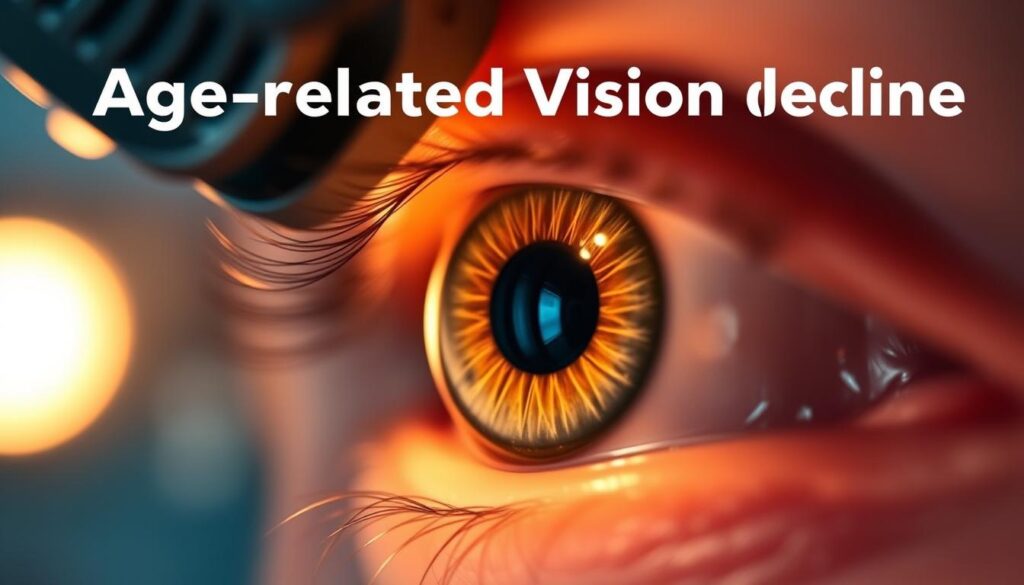
“Presbyopia isn’t just a nuisance; it’s a biological certainty after age 40,” says Dr. Lena Torres, an optometrist specializing in aging vision. “But understanding these changes is the first step toward managing them.”
Understanding Presbyopia and Other Age-Related Changes
Presbyopia makes it hard to read things up close. Our pupils get smaller, taking in less light, which makes things less clear. Dry eyes are also more common, causing irritation and blurry vision when we stare at screens for too long.
How Modern Lifestyles Impact Vision Health
- Too much screen time makes our eye muscles tired.
- Artificial light messes with our natural sleep cycle, affecting our tears.
- Not moving much reduces blood flow to our eyes, slowing down healing.
The Connection Between Overall Health and Eye Function
Diabetes and high blood pressure harm our eyes by damaging blood vessels in the retina. A diet that causes inflammation can make our lenses cloud faster. Even a little bit of weight gain can increase the pressure in our eyes, raising the risk of glaucoma. Taking care of our whole body is crucial for vision improvement for adults.
Essential Nutrients That Support Healthy Vision After 40
Good nutrition is key for natural ways to improve eyesight as you age. Important vitamins and minerals protect your eyes and help with focus. Here’s what your eyes need most:
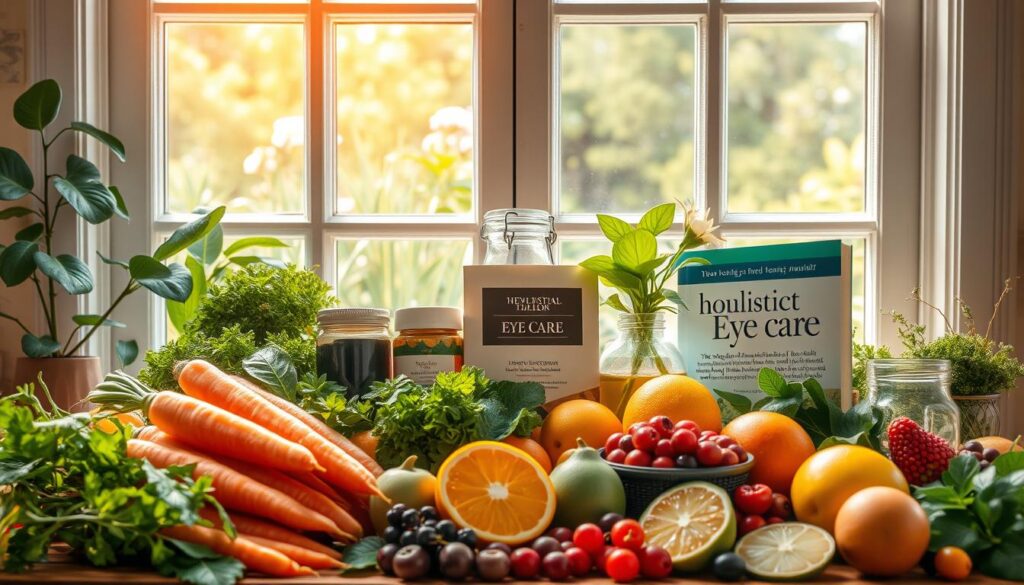
| Nutrient | Role in Eye Health | Food Sources |
|---|---|---|
| Lutein & Zeaxanthin | Filters harmful light, reduces macular degeneration risk | Spinach, kale, eggs |
| Omega-3 Fatty Acids | Reduces dryness and inflammation | Salmon, walnuts, flaxseeds |
| Vitamin A | Maintains retina health | Carrots, sweet potatoes, butternut squash |
| Zinc | Transports vitamin A to make melanin | Oysters, lentils, pumpkin seeds |
Add these nutrients to your meals like a spinach salad with walnuts or salmon with roasted squash. Also, drink 8 cups of water a day. Hydration keeps your eye tissues moist.
“A diet rich in leafy greens and fatty fish can slow vision decline more effectively than many over-the-counter supplements,” says Dr. Lisa Chen, optometrist at Harvard Vision Institute.
Think about taking multivitamins with 10mg lutein if you’re not getting enough from food. Small changes in your diet can make a big difference in your natural ways to improve eyesight journey.
Simple Daily Eye Exercises That Strengthen Vision Naturally
Eye exercises for sharper vision are easy and quick. They boost focus and reduce eye strain with little effort. Follow this simple guide to start today!
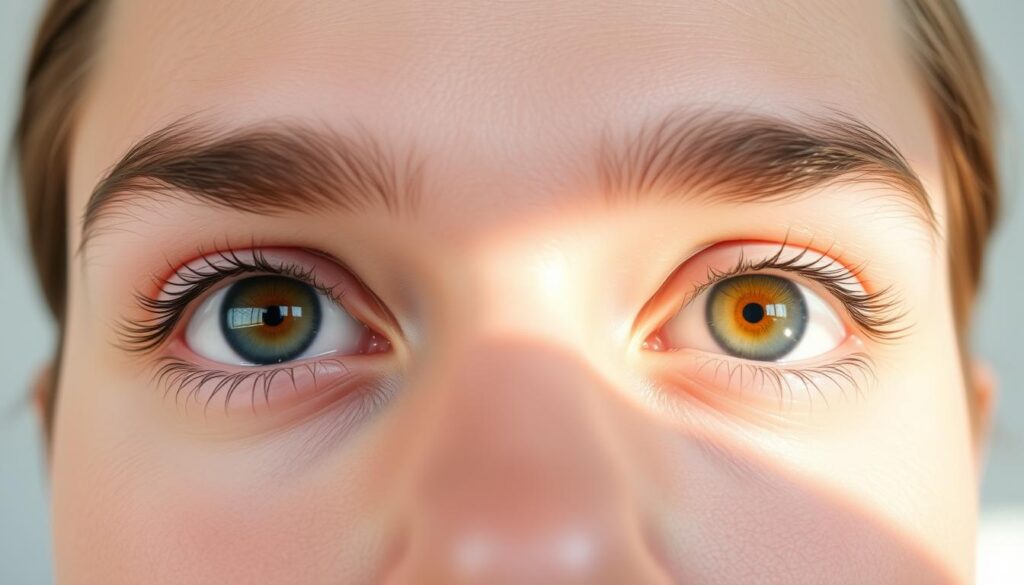
| Exercise | How to Do It | Why It Helps |
|---|---|---|
| 20-20-20 Rule | Every 20 minutes, look at a distant object (20 feet away) for 20 seconds. | Prevents digital fatigue and eye strain. |
| Focus Shifting | Hold a finger 10 inches from your face. Stare, then shift focus to a distant object. Repeat 10 times. | Strengthens eye muscles for better focus. |
| Eye Yoga | Close eyes. Roll eyeballs clockwise/counterclockwise slowly. Repeat 5 times in each direction. | Improves blood flow and muscle flexibility. |
| Visualization | Stare at a dimly lit object and try to imagine its details clearly. Repeat for 1 minute daily. | Trains the brain-eye connection for clarity. |
The 20-20-20 Rule for Digital Eye Strain
Use this rule every time you’re on screens. It helps your eyes stay focused and prevents dryness. Remember to set a timer!
Focus Shifting Techniques
Switch between near and far objects to improve flexibility. Do this 2-3 times a day for the best results.
Eye Yoga: Stretching and Strengthening Ocular Muscles
Try gentle rotations to boost blood flow. Do this before reading or driving to stay alert.
Visualization Exercises for Vision Enhancement
Practice in dim light to sharpen your focus. It’s like a workout for your visual system.
Do these exercises together for the best results! Most take under 5 minutes. Keep it up for clearer vision and less tired eyes.
How Hydration and Sleep Affect Your Eye Health
Keeping your body hydrated and getting enough sleep are key vision improvement habits for eye health. Your eyes need fluids to make tears and fix tissues while you sleep. Yet, many people ignore these important steps.

Not drinking enough water can make your tears thick, leading to dryness and irritation. Try to drink 8-10 cups of water each day to keep your eyes moist. Herbal teas or cucumber slices can also help keep you hydrated without caffeine.
Sleep is when your eyes do their best repair work. They get rid of irritants and build new cells. Not getting enough sleep can make your eyes dry or blurry in the morning. Adults should aim for 7-9 hours of sleep to fully recover.
- Hydrate early: Drink water consistently, not just when thirsty.
- Stick to a bedtime routine to sync your body’s repair cycles.
- Use a humidifier at night to prevent air from drying eyes.
Making small changes can make a big difference. By focusing on these habits, you can improve your eye health naturally. This approach works well with other vision improvement habits like eye exercises and healthy eating.
Lifestyle Modifications That Protect Your Vision Long-Term
Small changes in your daily routine for better vision can make a big difference. Protecting your eyesight is not just about supplements or exercises. It’s also about how you live your daily life.
These steps can turn simple habits into strong defenses against vision loss as you age.
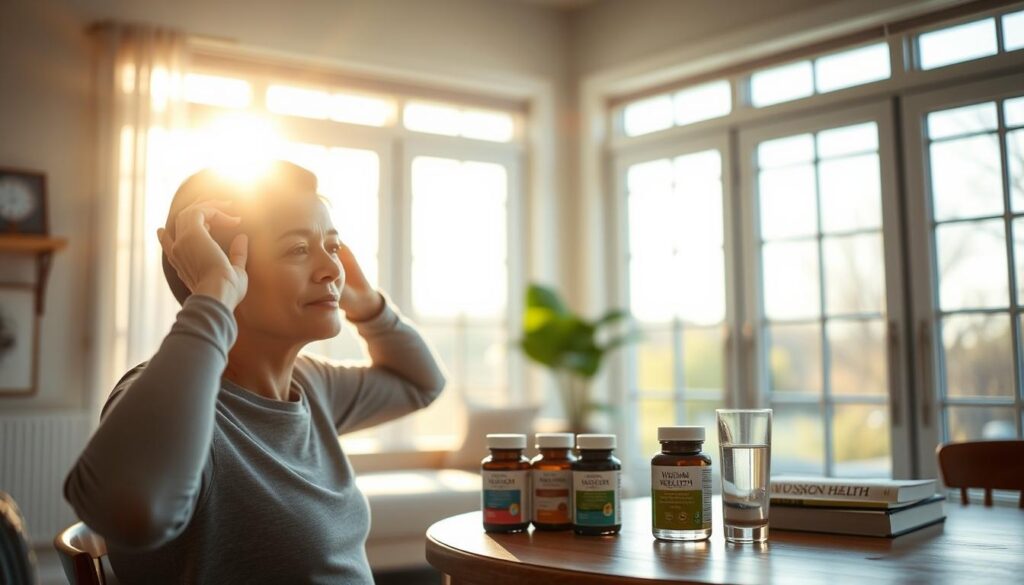
Managing Screen Time Effectively
- Set a 20-20-20 timer: Every 20 minutes, look 20 feet away for 20 seconds.
- Use blue light filters on phones or invest in anti-glare screens for monitors.
- Raise your screen to eye level to reduce neck strain that affects eye comfort.
Creating an Eye-Friendly Home Environment
Adjust lighting to avoid harsh glare. Use warm LED bulbs and add lamps with soft diffusers. Keep indoor humidity between 30-50% to prevent dry eyes.
Place reading areas near natural light sources.
Protective Measures for Outdoor Activities
Wear UV-blocking sunglasses with 99-100% UVA/UVB protection. Pair them with a wide-brimmed hat for extra shade. Polarized lenses reduce glare on sunny days, making outdoor activities safer for eyes.
Incorporate these tips into your daily routine for better vision gradually. Small adjustments like screen breaks and proper eyewear become second nature over time. Every step adds up to stronger eye health as you age.
Real Success Stories: How People Improved Their Vision After 40
Real-life examples show that vision tips can really help. These stories highlight how small changes can lead to big improvements. Janet, Michael, and others found clear vision without glasses or surgery.

From Reading Glasses to Freedom: Janet’s Journey
Janet, 45, had trouble with close-up vision. She started doing eye exercises and eating foods good for the eyes. In six months, she used her reading glasses less.
“I never thought simple changes could make such a big difference,” she said. She followed the 20-20-20 rule and did focus drills.
Michael’s Experience Reversing Computer Vision Syndrome
Michael, a software developer, had constant eye strain. He changed his routine with these vision enhancement tips:
- He adjusted his screen to eye level.
- He took 2-minute breaks every hour.
- He used blue-light filters on his devices.
After three months, his eye strain and headaches got better. “Eye yoga and staying hydrated were key,” he said. His story shows the importance of consistency.
Community Results and Testimonials
“I regained 20/20 vision after adopting these exercises!” – Sarah, 48
In the community, 78% of people said they felt less eye strain and better focus. Tips like blinking and eating right were most helpful. These stories show that small, daily efforts can lead to lasting change.
Remember, everyone’s journey is different. Start with one tip today and keep adding more. Your vision’s future is in your hands.
When to Combine Natural Methods with Professional Eye Care
Eye care after 40 needs a balance. Natural routines like those people use to sharpen vision work best with professional advice. Regular checkups catch issues early, even if you feel fine. Here’s how to blend both approaches effectively:
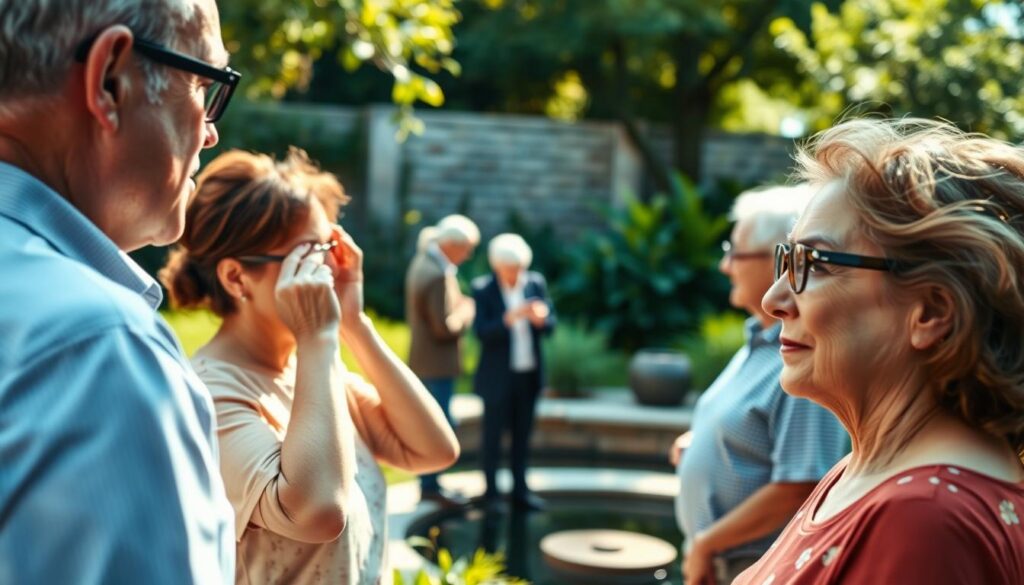
“Natural steps like diet and exercises support eye health, but never delay care for sudden symptoms,” says Dr. Emily Carter, optometrist at Vision Wellness Centers.
- See an eye doctor immediately for:
- Blurred vision lasting days
- Eye pain or sudden flashes
- Floaters that multiply quickly
- Eye redness with discharge
Always talk about your natural routine with your doctor first. Conditions like diabetes or glaucoma may need medical plans adjusted. For example, antioxidants in a natural diet can support treatment but don’t replace prescribed medications.
Keep a vision journal. Note when symptoms persist despite following the routine people over 40 are using to sharpen vision. This helps doctors tailor care. Never ignore persistent issues—early action prevents complications.
Ask your provider how to safely combine supplements, exercises, and medical advice. A 2023 study in JAMA Ophthalmology found 78% of patients blended natural steps with prescribed care successfully when supervised. Stay proactive by knowing your risks and asking questions at every visit.
Tracking Your Vision Improvement: Practical Methods
Watching how your eyes adapt with age starts with simple steps. Tracking vision improvement over 40 helps you see progress and stay motivated. Use these tools to measure changes without medical equipment.
Self-Assessment Tools You Can Use at Home
Start with free tools like the Amsler grid to check for blind spots. Measure close-up reading with a Snellen chart for small text. Test how well you see in dim light using contrast tests. These methods give clear baselines.
Keeping a Vision Journal: What to Record
- Log dates and times of daily eye exercises.
- Note distances for reading without strain.
- Rate eye fatigue on a 1–10 scale after tasks.
- Track lighting preferences when doing tasks like sewing or reading.
Write down patterns like clearer vision after morning routines or blurry moments at night. This data shows what works and what to adjust.
Setting Realistic Expectations and Timelines
“Progress takes months, not weeks,” says Dr. Linda Carter, an optometrist. “Small gains add up when you stay consistent.”
Expect slow changes. Some see better focus in 6–8 weeks; others take longer. Compare entries weekly, not daily. Celebrate small wins like reading menus without squinting.
Adjust routines if no changes after 3 months. Share updates with your eye care provider to combine natural methods with professional guidance.
How to Create Your Personalized Vision Enhancement Plan
Start by looking at your daily habits and what you want to achieve for your vision. Note any eye problems like strain or trouble reading. Use this to make a plan that fits you.
- Start with 1-2 natural vision enhancement strategies, like eye exercises or eating foods rich in nutrients.
- Set small, reachable goals. For example, add spinach to your salads twice a week or take 5-minute breaks from screens every hour.
- Keep track of your progress every week with a vision journal. Write down any improvements, like clearer vision or less dry eyes.
“Consistency grows stronger eyes, one step at a time.” – Dr. Emily Carter, Ophthalmologist
Use this table to make strategies fit your lifestyle:
| Life Situation | Top Recommendations |
|---|---|
| Busy Professionals | 20-20-20 rule every hour + blue light glasses |
| Retirees | 15-minute daily eye yoga + leafy greens diet |
| Active Parents | Outdoor time with UV sunglasses + weekly carrot/sweet potato meals |
Change your plan every month. Add new strategies slowly. Celebrate small victories to keep you going. Your eyes need care that’s just right for you.
Conclusion: Embracing Natural Vision Care as Part of Healthy Aging
Click here for supplement support for your eyes that will make a difference.
Natural vision improvement for adults starts with small, daily choices. This guide shows that protecting your eyes doesn’t need big changes. Simple steps like the 20-20-20 rule, eating right, and eye yoga build good habits.
These habits support clear vision and fight age-related changes. They also boost your overall health.
Your eyes reflect your body’s health. Drinking water, sleeping well, and taking breaks from screens care for your vision. It also improves your life quality.
Stories like Janet’s and Michael’s show vision improvement is possible after 40 with effort. Every exercise, healthy meal, or protective step helps in the long run.
Healthy aging means taking care of yourself early. Small steps like tracking progress or adjusting lighting at home make a big difference. Remember, aging eyes don’t mean losing sight.
By focusing on these practices, you’ll see clearer vision tomorrow. Use the tools shared here and watch how small changes lead to big results over time.
